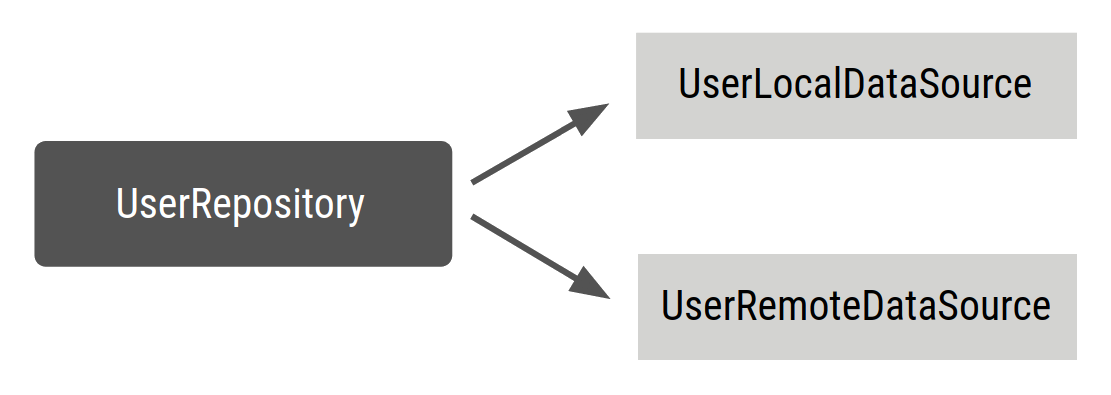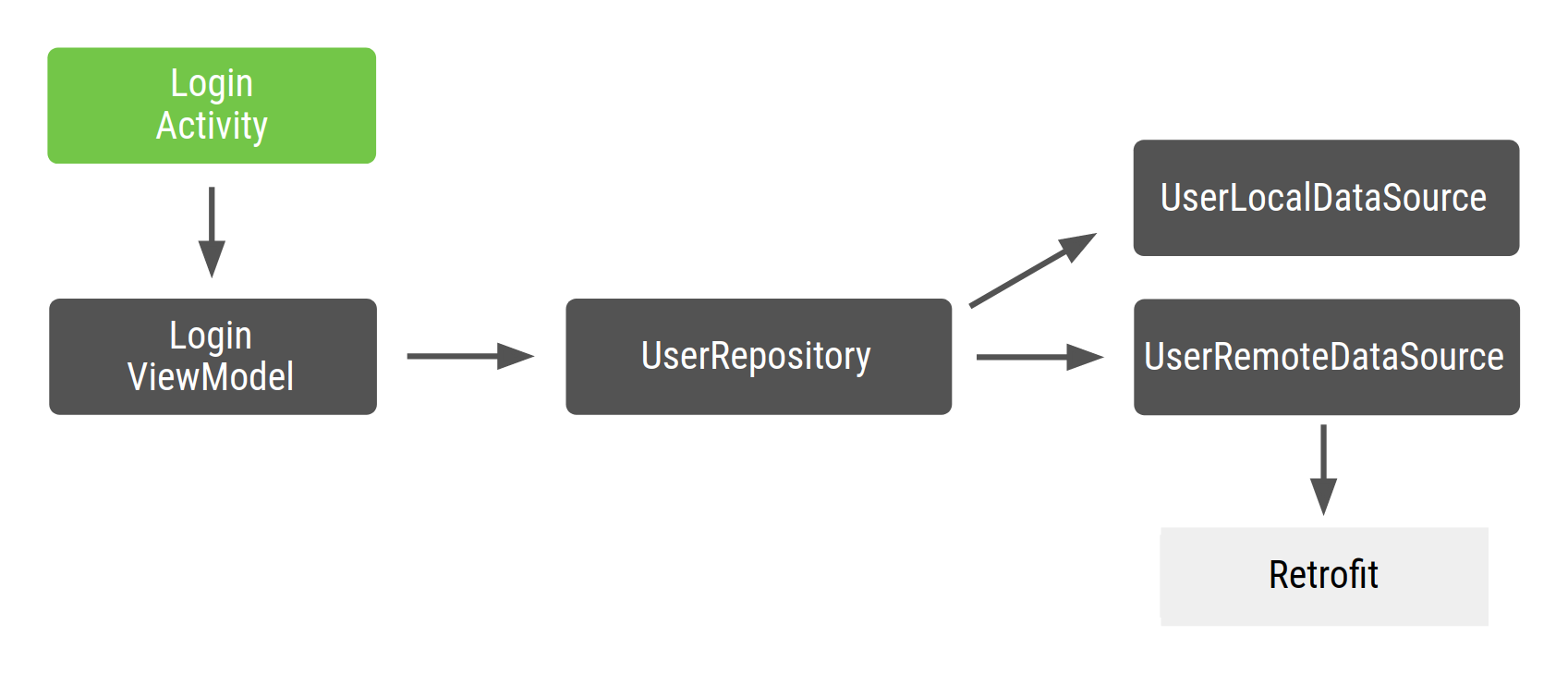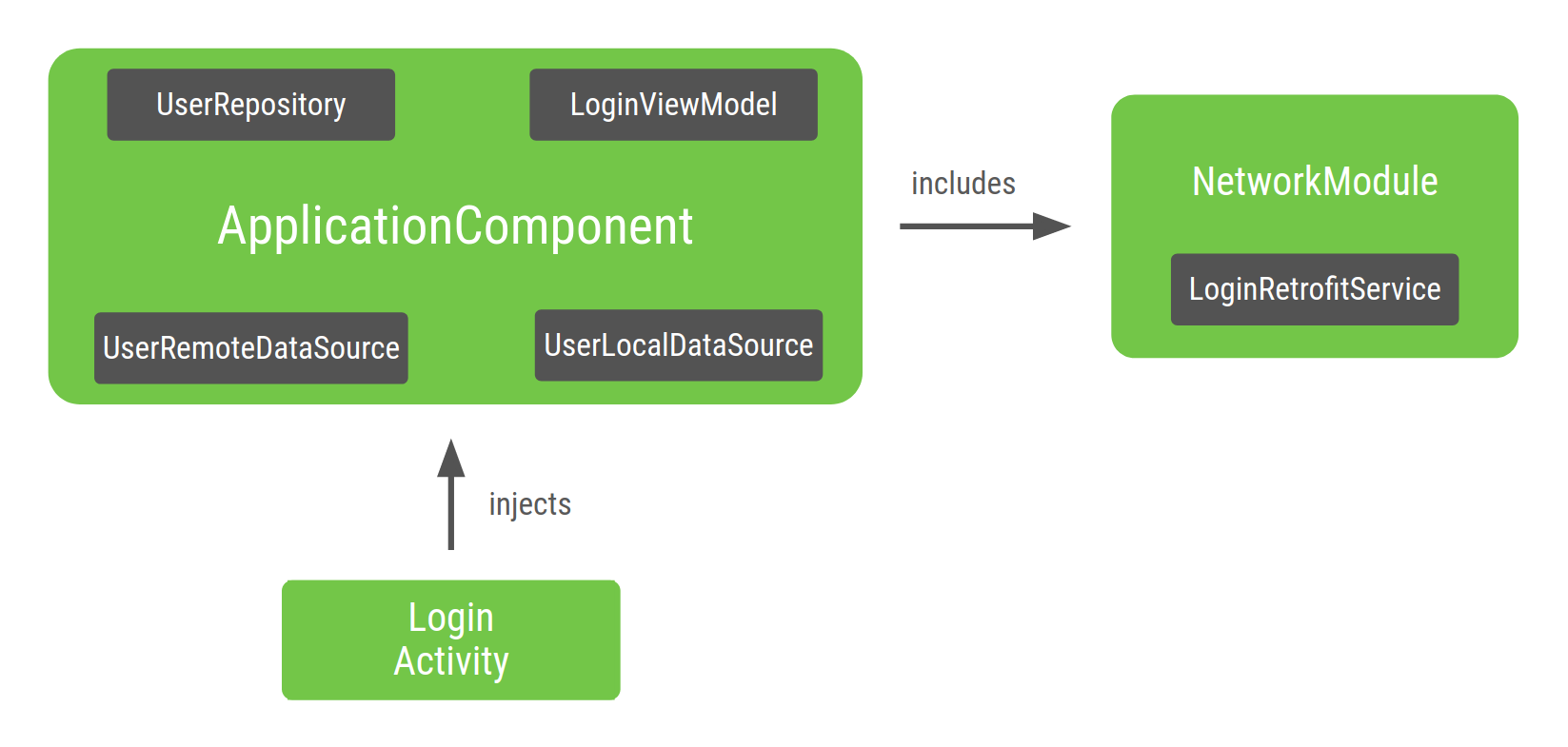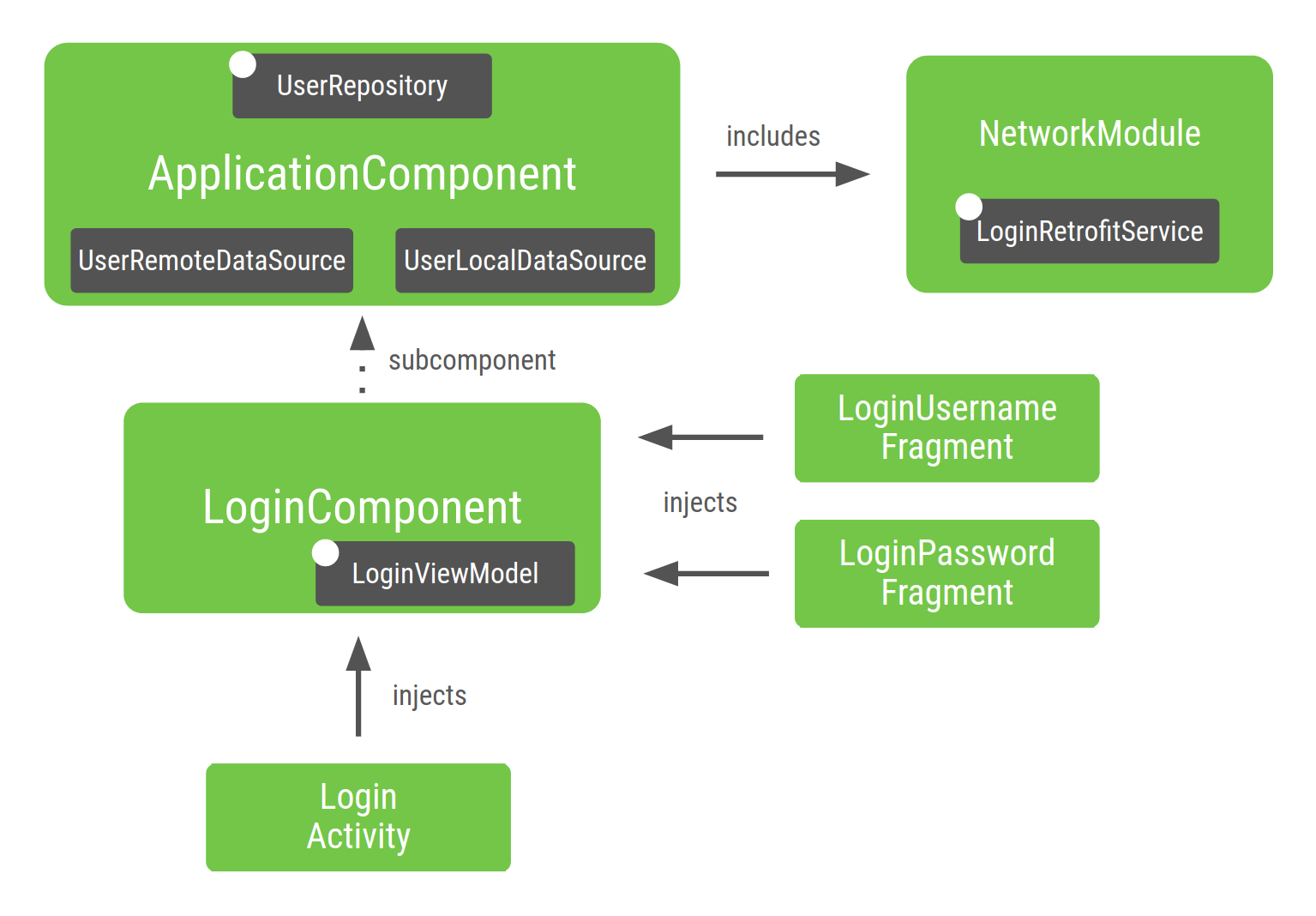Dagger 基础
根据项目的大小,Android 应用程序中的手动依赖项注入或服务定位器可能会出现问题。 可以通过使用 Dagger 管理依赖项来限制项目扩展时的复杂性。
Dagger 会自动生成模仿手写代码的代码。 由于代码是在编译时生成的,因此它是可追踪的,并且比 Guice 等其他基于反射的解决方案性能更高。
1 | 注意:在 Android 上使用 Hilt 进行依赖注入。 Hilt 构建在 Dagger 之上,它提供了将 Dagger 依赖项注入合并到 Android 应用程序中的标准方法。 |
使用 Dagger 的好处
Dagger 通过以下方式让你免于编写繁琐且容易出错的样板代码:
- 生成你在手动 DI 部分中手动实现的
AppContainer代码(application graph)。 - 为 application graph 中可用的类创建工厂。 这就是内部满足依赖关系的方式。
- 决定是否重用依赖项或通过使用 scope 创建新实例。
- 使用 Dagger 子组件为特定流创建容器。 这可以通过在不再需要内存中的对象时释放它们来提高应用程序的性能。
只要你声明类的依赖项并指定如何使用注解来满足它们,Dagger 就会在构建时自动执行所有这些操作。 Dagger 生成的代码与你手动编写的代码类似。
在内部,Dagger 创建一个 graph of objects,它可以引用该 graph of objects 来找到提供类实例的方法。 对于 graph 中的每个类,Dagger 都会生成一个工厂类型类,它在内部使用该类来获取该类型的实例。
在构建时,Dagger 会遍历你的代码并:
- 构建并验证 dependency graph,确保:
- 每个对象的依赖关系都可以得到满足,因此不存在运行时异常。
- 不存在依赖循环,因此不存在无限循环。
- 生成在运行时用于创建实际对象及其依赖项的类。
Dagger 中的一个简单用例:生成工厂
为了演示如何使用 Dagger,让我们为 UserRepository 类创建一个简单的工厂,如下图所示:

定义 UserRepository 如下:
1 | class UserRepository( |
将 @Inject 注释添加到 UserRepository 构造函数中,以便 Dagger 知道如何创建 UserRepository:
1 | // @Inject lets Dagger know how to create instances of this object |
1 | public class UserRepository { |
在上面的代码片段中,你告诉 Dagger:
- 如何使用
@Inject注解的构造函数创建UserRepository实例。 - 它的依赖项是:
UserLocalDataSource和UserRemoteDataSource。
现在 Dagger 知道如何创建 UserRepository 的实例,但不知道如何创建其依赖项。 如果你也注解其他类,Dagger 知道如何创建它们:
1 | // @Inject lets Dagger know how to create instances of these objects |
Dagger component
Dagger 可以在项目中创建 graph of the dependencies,以便在需要时找出应该从哪里获取这些依赖关系。 要让 Dagger 执行此操作,你需要创建一个接口并使用 @Component 进行注释。 Dagger 创建一个容器,就像手动依赖注入一样。
在 @Component 接口内部,你可以定义返回所需类实例的函数(即 UserRepository)。 @Component 告诉 Dagger 生成一个容器,其中包含满足其公开的类型所需的所有依赖项。 这称为 Dagger component; 它包含一个 graph,其中包含 Dagger 知道如何提供的对象及其各自的依赖项。
1 | // @Component makes Dagger create a graph of dependencies |
当你构建项目时,Dagger 会为你生成 ApplicationGraph 接口的实现:DaggerApplicationGraph。 通过其注释处理器,Dagger 创建了一个 dependency graph,该 dependency graph 由三个类(UserRepository、UserLocalDatasource 和 UserRemoteDataSource)之间的关系组成,
只有一个入口点:获取 UserRepository 实例。 你可以按如下方式使用它:
1 | // Create an instance of the application graph |
Dagger 在每次请求时都会创建一个新的 UserRepository 实例。
1 | val applicationGraph: ApplicationGraph = DaggerApplicationGraph.create() |
有时,你需要在容器中拥有唯一的依赖项实例。 你需要这个可能有几个原因:
- 你希望将此类型作为依赖项的其他类型共享同一实例,例如登录流中使用相同
LoginUserData的多个ViewModel对象。 - 创建对象的成本很高,并且你不希望每次将其声明为依赖项(例如,JSON 解析器)时都创建一个新实例。
在示例中,你可能希望 graph 中有一个可用的唯一 UserRepository 实例,以便每次请求 UserRepository 时,你总是会获得相同的实例。
这在你的示例中非常有用,因为在具有更复杂的 application graph 的现实应用程序中,你可能有多个取决于 UserRepository 的 ViewModel 对象,并且你不希望每次需要提供 UserRepository 时都创建 UserLocalDataSource 和 UserRemoteDataSource 的新实例 。
在手动依赖注入中,你可以通过将 UserRepository 的相同实例传递给 ViewModel 类的构造函数来实现此目的; 但在 Dagger 中,因为你不是手动编写该代码,所以你必须让 Dagger 知道你想要使用同一个实例。 这可以通过 scope annotation 来完成。
Scoping with Dagger
你可以使用 scope annotation 将对象的生命周期限制为其 component 的生命周期。 这意味着每次需要提供该类型时都会使用相同的依赖项实例。
要在 ApplicationGraph 中请求存储库时拥有唯一的 UserRepository 实例,请对 @Component 接口和 UserRepository 使用相同的 scope annotation。 你可以使用 Dagger 使用的 javax.inject 包附带的 @Singleton 注释:
1 | // @Component 接口上的 scope 注解告知 Dagger |
或者,你可以创建并使用自定义 scope annotation。 你可以按如下方式创建 scope annotation:
1 | // Creates MyCustomScope |
然后,你可以像以前一样使用它
在这两种情况下,对象都具有用于注释 @Component 接口的相同 scope。 因此,每次调用 applicationGraph.repository() 时,你都会获得相同的 UserRepository 实例。
Using Dagger in Android apps
最佳实践总结
- 只要有可能,就使用构造函数注入和
@Inject将类型添加到 Dagger graph 中。 当它不是时:|- 使用
@Binds告诉 Dagger 接口应该具有哪个实现。 - 使用
@Provides告诉 Dagger 如何提供你的项目不拥有的类。
- 使用
- 你应该只在 component 中声明一次模块
- 根据使用注释的生命周期来命名 scope annotation。 示例包括
@ApplicationScope、@LoggedUserScope和@ActivityScope。
Adding dependencies
要在项目中使用 Dagger,请将这些依赖项添加到应用程序的 build.gradle 文件中。 你可以在此 GitHub 项目中找到最新版本的 Dagger。
1 | // Kotlin |
1 | // Java |
Dagger in Android
考虑一个具有图 1 中的依赖关系图的示例 Android 应用程序。

在 Android 中,你通常会创建一个位于 application 类中的 Dagger graph,因为你希望只要应用程序正在运行,该 graph 的实例就位于内存中。
通过这种方式,该 graph 就附加到了应用程序生命周期中。 在某些情况下,你可能还希望 application context 在 graph 中可用。
为此,你还需要将 graph 放在 Application 类中。 这种方法的优点之一是该 graph 可供其他 Android framework 类使用。 此外,它允许你在测试中使用自定义应用程序类,从而简化了测试。
因为生成 graph 的接口是用 @Component 注解的,所以你可以将其称为 ApplicationComponent 或 ApplicationGraph。
你通常会在自定义 Application 类中保留该组件的一个实例,并在每次需要 application graph 时调用它,如以下代码片段所示:
1 | // Definition of the Application graph |
由于某些 Android framework 类(例如 activities and fragments)是由系统实例化的,因此 Dagger 无法为你创建它们。 特别是对于 activity,任何初始化代码都需要进入 onCreate() 方法。 这意味着你不能像在前面的示例中那样在类的构造函数中使用 @Inject 注释(构造函数注入)。 相反,你必须使用字段注入。
你希望 Dagger 为你填充这些依赖项,而不是在 onCreate() 方法中创建 activity 所需的依赖项。 对于字段注入,你可以将 @Inject 注释应用于要从 Dagger graph 中获取的字段。
1 | class LoginActivity: Activity() { |
为简单起见,LoginViewModel 不是 Android 架构组件 ViewModel; 它只是一个充当 ViewModel 的常规类。 有关如何注入这些类的更多信息,请查看 dev-dagger 分支中官方 Android Blueprints Dagger 实现中的代码。
Dagger 的考虑因素之一是注入的字段不能是私有的。 它们至少需要具有包私有可见性,如前面的代码所示。
1 | 注意:字段注入只能用在不能使用构造函数注入的 Android 框架类中。 |
Injecting activities
Dagger 需要知道 LoginActivity 必须访问该 graph 才能提供它所需的 ViewModel。 在 Dagger 基础知识页面中,你使用 @Component 接口通过公开具有要从 graph 中获取的内容的返回类型的函数来从 graph 中获取对象。
在这种情况下,你需要告诉 Dagger 需要注入依赖项的对象(本例中为 LoginActivity)。 为此,你公开一个函数,该函数将请求注入的对象作为参数。
1 |
|
该函数告诉 Dagger LoginActivity 想要访问该 graph 并请求注入。 Dagger 需要满足 LoginActivity 所需的所有依赖项(LoginViewModel 具有自己的依赖项)。 如果你有多个请求注入的类,则必须在组件中明确声明它们的确切类型。
例如,如果你有 LoginActivity 和 RegistrationActivity 请求注入,则你将有两个 inject() 方法,而不是涵盖这两种情况的通用方法。
通用的 inject() 方法不会告诉 Dagger 需要提供什么。 接口中的函数可以有任何名称,但在 Dagger 中,当它们接收要注入的对象作为参数时叫它们 inject() 是一种约定。
要在 activity 中注入对象,你可以使用 Application 类中定义的 appComponent 并调用 inject() 方法,传入请求注入的 activity 实例。
使用 Activity 时,请在调用 super.onCreate() 之前在 Activity 的 onCreate() 方法中注入 Dagger,以避免 fragment 恢复问题。
在 super.onCreate() 的恢复阶段,Activity 会附加可能想要访问 activity 绑定的 fragment。
使用 fragment 时,在 fragment 的 onAttach() 方法中注入 Dagger。 在这种情况下,可以在调用 super.onAttach() 之前或之后完成。
1 | class LoginActivity: Activity() { |
让我们告诉 Dagger 如何提供其余的依赖项来构建 graph:
1 | class UserRepository constructor( |
Dagger modules
在此示例中,你使用的是 Retrofit 网络库。 UserRemoteDataSource 依赖于 LoginRetrofitService。 但是,创建 LoginRetrofitService 实例的方法与你迄今为止所做的不同。 它不是一个类实例化;这是调用 Retrofit.Builder() 并传入不同参数来配置登录服务的结果。
除了 @Inject 注释之外,还有另一种方法告诉 Dagger 如何提供类的实例:Dagger 模块内的信息。 Dagger 模块是一个用 @Module 注解的类。 在那里,你可以使用 @Provides 注释定义依赖项。
1 | // @Module informs Dagger that this class is a Dagger Module |
1 | 注意:你可以在 Dagger 模块中使用 @Provides 注释来告诉 Dagger 如何提供你的项目不拥有的类(例如 Retrofit 的实例)。 |
模块是一种从语义上封装有关如何提供对象的信息的方法。 正如你所看到的,你调用了 NetworkModule 类来对提供与网络相关的对象的逻辑进行分组。 如果应用扩展,还可以在这里添加如何提供 OkHttpClient,或者如何配置 Gson 或 Moshi。
@Provides 方法的依赖项是该方法的参数。 对于前面的方法,LoginRetrofitService 可以不提供依赖项,因为该方法没有参数。 如果你已声明 OkHttpClient 作为参数,Dagger 需要从 graph 中提供 OkHttpClient 实例来满足 LoginRetrofitService 的依赖关系。 例如:
1 |
|
为了让 Dagger graph 了解这个模块,你必须将其添加到 @Component 接口,如下所示:
1 | // The "modules" attribute in the @Component annotation tells Dagger what Modules |
向 Dagger graph 中添加类型的推荐方法是使用构造函数注入(即在类的构造函数上使用 @Inject 注释)。 有时,这是不可能的,你必须使用 Dagger 模块。
一个例子是当你希望 Dagger 使用计算结果来确定如何创建对象的实例时。 每当需要提供该类型的实例时,Dagger 都会运行 @Provides 方法内的代码。
这就是示例中的 Dagger graph 现在的样子:

该 graph 的入口点是 LoginActivity。 由于 LoginActivity 注入 LoginViewModel,Dagger 构建了一个 graph,该 graph 知道如何提供 LoginViewModel 的实例,并递归地提供其依赖项。 Dagger 知道如何执行此操作,因为类构造函数上有 @Inject 注释。
在 Dagger 生成的 ApplicationComponent 内部,有一个工厂类型的方法来获取它知道如何提供的所有类的实例。 在此示例中,Dagger 委托给 ApplicationComponent 中包含的 NetworkModule 来获取 LoginRetrofitService 的实例。
Dagger scopes
Dagger 基础知识页面上提到了 scope 作为在组件中拥有类型的唯一实例的一种方式。 这就是将类型的 scope 限定到组件的生命周期的含义。
由于你可能希望在应用程序的其他功能中使用 UserRepository,并且可能不希望每次需要时都创建一个新对象,因此你可以将其指定为整个应用程序的唯一实例。LoginRetrofitService 也是如此:创建成本可能很高,而且你还希望重用该对象的唯一实例。 创建 UserRemoteDataSource 的实例并不那么昂贵,因此没有必要将其 scope 限定到组件的生命周期。
@Singleton 是 javax.inject 包附带的唯一 scope 注释。 你可以使用它来注释 ApplicationComponent 以及你想要在整个 application 中重用的对象。
1 |
|
1 | 注意:使用 scope 注释的模块只能在使用相同 scope 注释的组件中使用。 |
将 scope 应用于对象时,请注意不要引入内存泄漏。 只要 scoped component 位于内存中,创建的对象也位于内存中。 因为 ApplicationComponent 是在应用程序启动时创建的(在 Application 类中),所以当应用程序被销毁时它也会被销毁。 因此,UserRepository 的唯一实例始终保留在内存中,直到应用程序被销毁。
1 | 注意:使用构造函数注入(使用 @Inject)时在类中添加 scope 注释,并在使用 Dagger 模块时将它们添加到 @Provides 方法中。 |
Dagger subcomponents
如果你的登录流(由单个 LoginActivity 管理)包含多个 fragment,则应在所有 fragment 中重用相同的 LoginViewModel 实例。 @Singleton 无法注释 LoginViewModel 以重用实例,原因如下:
- 流程完成后,
LoginViewModel的实例将保留在内存中。 - 你需要为每个登录流程使用不同的
LoginViewModel实例。 例如,如果用户注销,你需要一个不同的LoginViewModel实例,而不是与用户第一次登录时相同的实例。
要将 LoginViewModel 的 scope 限定为 LoginActivity 的生命周期,你需要为登录流程和新 scope 创建一个新组件(新的 subgraph)。
让我们创建一个特定于登录流程的 graph。
1 |
|
现在,LoginActivity 应该从 LoginComponent 获取注入,因为它具有特定于登录的配置。 这消除了从 ApplicationComponent 类注入 LoginActivity 的责任。
1 |
|
LoginComponent 必须能够访问 ApplicationComponent 中的对象,因为 LoginViewModel 依赖于 UserRepository。 告诉 Dagger 你希望新组件使用另一个组件的一部分的方法是使用 Dagger subcomponent。 新组件必须是包含共享资源的组件的 subcomponent。
Subcomponent 是继承并扩展父组件的 object graph 的组件。 因此,父组件中提供的所有对象也在子组件中提供。 这样,子组件中的对象可以依赖于父组件提供的对象。
要创建子组件的实例,你需要父组件的实例。 因此,父组件向子组件提供的对象的 scope 仍然是父组件。
在示例中,你必须将 LoginComponent 定义为 ApplicationComponent 的子组件。 为此,请使用 @Subcomponent 注释 LoginComponent:
1 | // @Subcomponent annotation informs Dagger this interface is a Dagger Subcomponent |
你还必须在 LoginComponent 中定义一个子组件工厂,以便 ApplicationComponent 知道如何创建 LoginComponent 的实例。
1 |
|
要告诉 Dagger LoginComponent 是 ApplicationComponent 的子组件,你必须通过以下方式指示它:
创建一个新的 Dagger 模块(例如
SubcomponentsModule),将子组件的类传递给注释的subcomponents属性。1
2
3
4// The "subcomponents" attribute in the @Module annotation tells Dagger what
// Subcomponents are children of the Component this module is included in.
class SubcomponentsModule {}将新模块(即 SubcomponentsModule)添加到 ApplicationComponent:
1
2
3
4
5
6// Including SubcomponentsModule, tell ApplicationComponent that
// LoginComponent is its subcomponent.
interface ApplicationComponent {
}请注意,
ApplicationComponent不再需要注入LoginActivity,因为该责任现在属于LoginComponent,因此你可以从ApplicationComponent中删除inject()方法。ApplicationComponent的使用者需要知道如何创建LoginComponent的实例。 父组件必须在其接口中添加一个方法,以允许使用者从父组件的实例中创建子组件的实例:在接口中公开创建
LoginComponent实例的工厂:1
2
3
4
5
6
7
interface ApplicationComponent {
// This function exposes the LoginComponent Factory out of the graph so consumers
// can use it to obtain new instances of LoginComponent
fun loginComponent(): LoginComponent.Factory
}
Assigning scopes to subcomponents
如果构建项目,则可以创建 ApplicationComponent 和 LoginComponent 的实例。 ApplicationComponent 附加到 application 的生命周期,因为只要 application 位于内存中,你就希望使用同一 graph 实例。
LoginComponent 的生命周期是怎样的? 你需要 LoginComponent 的原因之一是因为你需要在与登录相关的 fragment 之间共享相同的 LoginViewModel 实例。
而且,每当有新的登录流程时,你都需要 LoginViewModel 的不同实例。 LoginActivity 是 LoginComponent 的正确生命周期:对于每个新 activity,你需要一个新的 LoginComponent 实例和可以使用该 LoginComponent 实例的 fragment。
由于 LoginComponent 附加到 LoginActivity 生命周期,因此你必须在 activity 中保留对组件的引用,就像在 Application 类中保留对 applicationComponent 的引用一样。 这样,fragment 就可以访问它。
1 | class LoginActivity: Activity() { |
请注意,变量 loginComponent 未使用 @Inject 进行注释,因为你不希望 Dagger 提供该变量。
你可以使用 ApplicationComponent 获取对 LoginComponent 的引用,然后注入 LoginActivity,如下所示:
1 | class LoginActivity: Activity() { |
LoginComponent 是在 Activity 的 onCreate() 方法中创建的,当 Activity 被销毁时,它会被隐式销毁。
每次请求时,LoginComponent 必须始终提供相同的 LoginViewModel 实例。 你可以通过创建自定义注释 scope 并用它注释 LoginComponent 和 LoginViewModel 来确保这一点。
请注意,你不能使用 @Singleton 注释,因为它已被父组件使用,这会使该对象成为 application 单例(整个应用程序的唯一实例)。 你需要创建不同的注释 scope。
1 | 注意:scope 规则如下: |
在这种情况下,你可以将此 scope 称为 @LoginScope,但这不是一个好的做法。 scope 注释的名称不应明确说明其所实现的目的。
相反,它应该根据其生命周期来命名,因为注释可以被同级组件(例如 RegistrationComponent 和 SettingsComponent)重用。
这就是为什么你应该将其命名为 @ActivityScope 而不是 @LoginScope。
1 | // Definition of a custom scope called ActivityScope |
现在,如果你有两个需要 LoginViewModel 的 fragment,则它们都提供有相同的实例。 例如,如果你有 LoginUsernameFragment 和 LoginPasswordFragment,它们需要由 LoginComponent 注入:
1 |
|
这些组件访问 LoginActivity 对象中的组件实例。 LoginUserNameFragment 的示例代码显示在以下代码片段中:
1 | class LoginUsernameFragment: Fragment() { |
图 3 显示了带有新子组件的 Dagger graph的外观。 带白点的类(UserRepository、LoginRetrofitService 和 LoginViewModel)是具有其各自组件范围的唯一实例的类。

让我们分解一下 graph 的各个部分:
NetworkModule(以及LoginRetrofitService)包含在ApplicationComponent中,因为你在组件中指定了它。UserRepository保留在ApplicationComponent中,因为它的作用域为ApplicationComponent。 如果项目不断增长,你希望在不同功能(例如注册)之间共享相同的实例。
由于UserRepository是ApplicationComponent的一部分,因此它的依赖项(即UserLocalDataSource和UserRemoteDataSource)也需要位于该组件中,以便能够提供UserRepository的实例。LoginViewModel包含在LoginComponent中,因为只有LoginComponent注入的类才需要它。LoginViewModel不包含在ApplicationComponent中,因为ApplicationComponent中没有依赖项需要LoginViewModel。
类似地,如果你没有将UserRepository范围限定为ApplicationComponent,Dagger 会自动将UserRepository及其依赖项作为LoginComponent的一部分包含在内,因为这是当前唯一使用UserRepository的地方。
除了将对象的范围限定到不同的生命周期之外,创建子组件是将应用程序的不同部分相互封装的一个好习惯。
根据应用程序的流程构建应用程序以创建不同的 Dagger 子图有助于在内存和启动时间方面实现更高性能和可扩展的应用程序。
Best practices when building a Dagger graph
为你的应用程序构建 Dagger graph 时:
- 创建组件时,你应该考虑哪个元素负责该组件的生命周期。 在本例中,
Application类负责ApplicationComponent,LoginActivity负责LoginComponent。 - 仅在有意义时才使用 scope。 过度使用 scope 会对应用程序的运行时性能产生负面影响:只要组件位于内存中,对象就位于内存中,并且获取 scope 对象的成本更高。 当 Dagger 提供对象时,它使用
DoubleCheck锁定而不是工厂类型提供程序。
Working with Dagger modules
Dagger 模块是一种封装如何以语义方式提供对象的方法。 你可以在组件中包含模块,但也可以在其他模块中包含模块。 这很强大,但很容易被滥用。
一旦一个模块被添加到一个组件或另一个模块中,它就已经在 Dagger graph 中了; Dagger 可以在该组件中提供这些对象。 在添加模块之前,请检查该模块是否已是 Dagger graph 的一部分,方法是检查该模块是否已添加到组件中,或者编译项目并查看 Dagger 是否可以找到该模块所需的依赖项。
良好的实践表明,模块只能在组件中声明一次(在特定的高级 Dagger 用例之外)。
假设你以这种方式配置了 graph。 ApplicationComponent 包括 Module1 和 Module2,Module1 包括 ModuleX。
1 |
|
如果现在 Module2 依赖于 ModuleX 提供的类。 不好的做法是将 ModuleX 包含在 Module2 中,因为 ModuleX 在 graph 中包含了两次,如以下代码片段所示:
1 | // Bad practice: ModuleX is declared multiple times in this Dagger graph |
相反,你应该执行以下操作之一:
- 重构模块并将公共模块提取到组件中。
- 使用两个模块共享的对象创建一个新模块,并将其提取到组件中。
不以这种方式重构会导致许多模块相互包含而没有清晰的组织感,并且更难以看出每个依赖项来自何处。
良好实践(选项 1):ModuleX 在 Dagger graph 中声明一次。
1 |
|
良好实践(选项 2):ModuleX 中 Module1 和 Module2 的公共依赖项被提取到包含在组件中的名为 ModuleXCommon 的新模块中。 然后,使用特定于每个模块的依赖项创建另外两个名为 ModuleXWithModule1Dependency 和 ModuleXWithModule2Dependency 的模块。 所有模块都在 Dagger graph 中声明一次。
1 |
|









